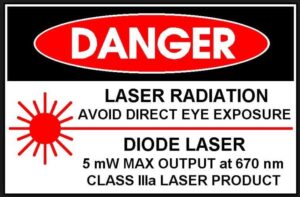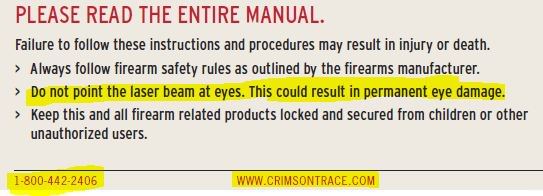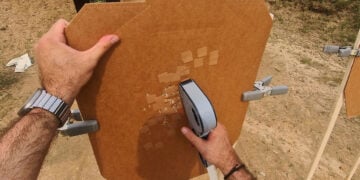
There does NOT seem to be a consensus about the use of lasers for firearms sighting. This is a very controversial subject. Some shooters are strongly in favor of the use of laser sights, while others are definitely opposed to them and favor iron sights and/or night sights. Some say that using nice-to-have laser sights are NOT an alternative to using iron sights. The latter believe that knowing the fundamentals of aiming, sight alignment, and sight picture are most important and must be learned with iron sights before optional laser sights are even considered. By focusing on and relying only on laser sights, the development of necessary muscle memory and the basic skills of aiming are overlooked. Those favoring laser sights say if it’s dark enough to use the laser, it’s probably too dark to use the iron sights. Further, they claim that if you get in a sudden, life and death, face-to-face close-quarters shooting situation, it’s very unlikely you’ll use the sights anyway and will use no sighting with point-and-shoot or brief Flash Sight Picture sighting. Some believe with a laser sight they can naturally and innately shoot more precisely, while others believe that you must have the regular practice with the proper gun and equipment to be able to successfully shoot for center mass, so the laser just helps you acquire that a little faster. Others point out that with laser sights you point at the TARGET, while with iron sights you aim at the front SIGHT. So there are many considerations, options, preferences, and alternatives to think about. As with any topic there are supporters and detractors and various opinions, so it is up to YOU to make a personal decision about laser sights for your firearm, given your goals, priorities, skills, budget, risks, and uses. I hope the following pros and cons and information help you make your personal decision.
Recognize that a firearm’s laser sight’s primary purpose is simply to create an intense, visible dot of colored concentrated light on the intended target surface or bad guy/gal. Technically, a laser is a device that emits light through a process of optical amplification based on the emission of electromagnetic radiation. I’m not sure about all that technically, but the term “LASER” is an acronym that stands for “Light Amplification by Stimulated Emission of Radiation.” Lasers differ from other sources of light because they emit light that can be focused to a well-defined, exact small spot. I believe that when used responsibly, lasers are generally safe. However, a powerful laser and its radiation used irresponsibly is unsafe, particularly when misused as a toy or directed at people, vehicles, or aircraft. You must have the knowledge and skill from regular practice and use to act responsibly with your laser sights. More on laser safety later.
General Laser Information
Gun laser sights usually emit a narrow spectrum of light, e.g. like red or green light, but other colors are available. Red lasers are the most common, but that is changing. They require a relatively low level of energy to run and are usually less expensive and compact in size. The drawback of red lasers is that they are difficult to see in bright sun light, only being visible out to about 20-30 feet. Some models offer a pulsing beam, one that flashes on and off, to make the target point easier to spot. Green lasers offer a brighter, easier-to-see target point. I am color-blind and the green laser shows up much more for me. I can barely see the red laser in any light condition, but the green really sticks out to me, given my red-green color blindness. Because the human eye is more receptive to this color, some green lasers can be seen in bright sunlight out to100 yards, as well as in dim and dark situations. However, green lasers are more complicated to construct and they drain battery power more quickly, so they tend to be bulkier and more expensive. Also, green lasers are sensitive to ambient temperature and can malfunction in extremely cold weather. A cost-benefit analysis will help you choose the color of laser beam for your firearm sights. Red is at its best at relatively close ranges in moderate and low light situations. Since these are probably the conditions the average person will use them for self-defense, the more affordable red laser is often sufficient for most defensive applications. Green lasers, due to their greater range and flexibility, have been readily adapted for military and law enforcement applications despite their added expense. Since everyone wants the best laser possible, developers are striving to build green beams in more compact and affordable formats. My three self-defense and competition guns all have green laser sights, primarily because of my color deficiency.
 Safety of Firearms Lasers
Safety of Firearms Lasers
All lasers are recognized as being potentially dangerous and Theodore Maiman, the inventor of the first laser in 1960, recognized the first laser as having a power of one “Gillette” since it could burn through one Gillette Razor Blade. Today, it is accepted by the medical and workplace communities that even low-power lasers with only a few milliwatts of output power can be hazardous to human eyesight when the beam hits the eye directly or after reflection from a shiny surface, according to the encyclopedia Wikipedia. Just like with guns and ammunition, a laser sight should be stored securely to prevent unauthorized access.
The Food and Drug Administration (FDA) requires that labeling on most laser products (e.g. Class IIIA and above) contain a warning about radiation and other hazards and a statement certifying that the laser complies with FDA safety regulations. Class IIIA applies to firearms. The FDA requires that the label must also state the product’s output power and hazard class. Here are some example laser warning labels:


Some safety compliance labeling says that operation of a laser without the required safety labeling may violate federal law, i.e. 21 CFR 1040. The FDA requires the label supplied with your laser be affixed to the outside of the gun with the arrow pointing to the laser aperture. While this is a pain and most will never note the warning, I recommend that shooters “bite the safety bullet” and attach the laser “Danger Warning Label” that comes with your laser sight onto your firearm. This will keep you in compliance with federal laws and may help to avoid a potential legal technicality problem for a possible shooting encounter or if another handles your weapon. Why take the small chance of risking non-compliance and paying big bucks later for the mere two seconds it takes to place the label on your firearm? Your call!
The label contains the required warning for a class IIIA laser for a firearm. There is a certification section in the firearms manual stating that the manufacturer (e.g. LaserMax or Crimson Trace) certifies product compliance with FDA regulations, manufacturer’s address, and the month and year of manufacture. A recent set of firearm laser sights, according to the manufacturer’s instruction manual, states that the laser sight has the following specifications:
Laser Type: Class IIIa visible laser Diode
Peak Power: 5 mW
Wavelength: 633nm
Color: Red
Beam Size: Approx. 0.5 inches at 50′
Battery Type: (2) CR2032 or DL2032 lithium cells
Battery Life: 3 hours; 4 year shelf life
The FDA restricts the output power of visible lasers that can be sold to “civilians” to no more than 5 milliwatts (mW) and classifies lasers we are allowed to buy for firearms as Class IIIA. Generally, they are deemed “eye safe” because if you happen to stare at one, your brain would trigger a blink reflex long before the laser could damage your retina. Because infrared lasers (Class IV) are invisible and thus cannot cause a blink reflex, the FDA highly regulates their sale.
Crimson Trace states this in their laser sights manual:

Also according to the manufacturer’s instruction manual for a firearms laser sight, “Laser products must only be operated with the safety label applied to the firearm.” The labels state that they comply with 21 CFR 1040.10. It seems many shooters do not apply the safety label on their defensive firearms for various reasons. Some think it is only to hold manufacturers responsible and legally liable for their products. The interpretation of the intent seems to be for a responsible safety purpose to remind shooters of the laser danger. Recognize that a laser can be focused by the eye into an extremely small spot on the retina, which can result in localized burning and permanent damage in seconds. If laser light is intensified and concentrated, it has a SERIOUS potential AT ANY strength or frequency to damage the retina or lens, according to Wikipedia encyclopedia. Do we want to even take a 1% chance on this possible damage? Be cautious. The military, of course, uses invisible and highly destructive infrared lasers in weapons systems and have specially designed diffusing lenses in their goggle systems, while several commercial systems ban lasers for a reason. They cannot significantly control what wattage the laser has. The higher the watts, the stronger the laser is and the more damage it can do. This is not to say that a low wattage laser won’t cause damage, rather it is a matter of the extent of the possible damage which is subjectively determined by the testing methods used. Even laser pointers used in training and education with low wattage can be dangerous, but there are currently no restrictions for purchasing laser pointers in the United States. However, the FDA has issued a warning for laser pointers, urging that the pointers be used as intended, not as toys, and not by children unless under adult supervision. Class 1 lasers are inherently safe, usually because the light is contained in an enclosure, for example in CD players. While Class Class 3B can cause immediate eye damage upon exposure and Class 4 lasers can burn skin and can cause permanent eye and/or skin damage. Class III lasers for firearms are usually considered direct fire weapons by the Military and Law Enforcement. Laser beams can be formed by a number of methods, but firearm laser sights—whether green, red or even blue, visible or invisible—all utilize semiconductor diodes to create beams.
Laser Use Guidelines
Laser are effective tools when used properly, but the following guidelines should be observed when using them:
- Never look directly into the laser beam.
- Never point a laser beam at a person.
- Do not aim the laser at reflective surfaces.
- Never view a laser pointer using an optical instrument, such as binoculars or a microscope.
- Do not allow children to use laser pointers unless under the supervision of an adult.
- Use only lasers meeting the following criteria:
- Labeled with FDA certification stating “DANGER: Laser Radiation” for Class 3A firearms lasers or “CAUTION: Laser Radiation” (Class 2 pointers)
- Classified as Class 2 or 3A according to the label. Do not use Class 3B or 4 products.
- Operates at a wavelength between 630 nm and 680 nm.
- Has a maximum output less than 5 mW; the lower the better and more safe.
The FDA has described incidents of pilots experiencing temporary flash-blinding from lasers from various sources, including laser firearms sights and laser training pointers. In 2009, pilots reported 1,500 incidents and in the first 10 months of 2010, there were 2,231 incidents, according to FDA data. The FDA states that “Using a laser to illuminate aircraft is a federal crime.” A laser beam outdoors can seem to end after only a few hundred yards, but facts show that the beam actually continues to travel, even though the viewer can no longer see the light scattered back to them. Instead of a few hundred yards, a laser beam can be a hazard to pilots miles away. For example, even a relatively weak U.S.-legal 5 mW laser firearm sight is a distraction hazard to pilots over two miles away. In 2011, a 14-year-old boy was arrested for illuminating an aircraft on approach to Los Angeles International Airport. He told police that he thought the beam “would not go up to the height of the aircraft.” He was wrong, of course. So, always act as if the beam continues on, forever.
Laser Sight Housings, Rails, Holsters, and Guide Rods
There are several laser sight systems to consider for your firearm. The laser sight housing has two purposes: to act as the structure to hold all of the laser’s components together and to allow the laser to be mounted to the specific firearm. Since guns come in a variety of shapes and sizes, so do the housings. Using accessory rails as a laser sight housing on handguns allow shooters to easily install rail-mounted laser sights to their firearms without any permanent alterations to them. The downside of rail-mounted laser sights is they add bulk and weight to a gun. Depending on your firearm and its laser sights, you may need to buy a holster designed to accommodate the laser and that may not be an easy task.
The guide rod laser sight system replaces the manufacturer’s guide rod of a semi-auto pistol with a laser guide rod. The downside of this system is that if the laser housing breaks, the entire pistol is not functional. The LaserMax brand has internal guide rod laser sights (with an on/off switch) for semi-automatic pistols made by Beretta, Glock, ParaOrdinance, SigArms, Springfield, the Model 1911 Colt 45, etc.
Another popular system is laser grips which replace the factory grips on pistols and revolvers. The switch to activate the laser is set in such a way that the laser is activated when the handgun is held naturally in the shooting hand. If there is a downside to this arrangement, it’s that the position of the shooting or support hand may obscure the path of the laser beam if the shooter is not paying attention. Crimson Trace brand has external laser grip sights and internal laser sights with external button activation switches for Glock, Kel-Tec, Ruger, Sig Sauer, Smith & Wesson, etc.
The Pros & Cons of Laser Sights
The positives of the laser sights are obvious. They allow the shooter to get the gun on target quickly, even in low light, without having to spend much time lining up the iron sights. The laser can help to get the gun back on target for accurate follow-up shots. In addition to close-up defensive situations, lasers are useful training aids. They help the shooter to see if and to what extent the firearm is moving during target practice. They are useful for dry-fire exercise, since the shooter can see if he/she is flinching, heeling, slapping the trigger, and pulling your shots off target. The laser’s greatest strength might also be its greatest weakness. The focused beam produces a perfectly straight line from Point A to Point B, but bullets do not always move in a straight path from the muzzle to the target. Lasers do not always stay sighted in properly in a straight line. A flinch, movement of the hand or wrist, or jerk of the trigger will wave that straight beam around significantly, with the shot landing off-target, even though the laser indicated you were on-target just a moment before you shot. Also, just like a tactical light, the laser can give away the location of the shooter in low-light conditions.
Modern laser sights built by reputable companies are rugged and reliable and should give the user reliable results during usual use. However, they are electronic and mechanical devices that can malfunction or fail. A shooter can leave their home defense firearm in their nightstand and easily forget to regularly change the required batteries. Given the short 3 to 4 hour battery life, battery strength tends to lessen and may not be fully-powered. This could be a life threatening situation. Also, the action mechanisms that fire your handgun may not survive and function after a drop onto concrete or a water bath; be prepared for the laser’s possible demise. Consider these pros and cons.
PROS of a Laser Sight
- Quick and accurate alignment of your firearm on the Target or threat.
- Rapid accurate follow-up shots on the Target or threat, if required by the situation.
- Rapid movement to engage multiple targets in different locations at different distances.
- Dry fire training aid to practice with your firearm at a target and seeing how the point of bullet impact changes as you press the trigger. Training helps with proper grip and trigger press.
- Quick realignment of your firearm on a Target when moving to a different location and cover.
- Accurate shooting around or over some type of cover using the dot without having to physically sight your firearm.
- Focus on the Target instead of focusing on your Front Sight (some consider this a disadvantage.)
- Permits a wider field of peripheral vision because you are focusing on a more distant object instead of a closer front sight. You can see multiple threats to the side at the same time.
CONS of a Laser Sight
- Laser dot is very difficult and sometimes impossible to see in bright sunlight in daytime outdoors.
(Note: In artificial light a laser dot is usually easier to see, even if indoors.) - Makes you dependent on a mechanical device that may malfunction or not work properly.
- Requires batteries and regular replacement of them for proper performance at critical time of need.
- Detracts from learning and applying the fundamentals of basic aiming, sight alignment, and sight picture. (Note: One should continue to practice without your laser sight each time you practice with your laser sight. This will help you remain proficient and accurate with and without a laser sight.)
- On a bright sunny day or in problem scenarios when you can’t see your laser dot on the target or when malfunctions occur, you need to be mentally prepared to shoot by focusing on your front sight and aiming properly. If you hesitate on a bright sunny day during a stressful gunfight then you may get killed.
- Laser sights are relatively expensive. A handgun laser sight will usually cost somewhere between $180 to $400.
- Tritium night sights are a less expensive option and are always on once daylight becomes scarce.
- Laser sight alignment is affected by shooting distances & may require adjustment. So know the bullet trajectory of your specific cartridge & make proper adjustments for accuracy.
See the below excerpt from a laser sight manual:

Final Thoughts
Lasers are a useful addition to the modern handgun accessory toolkit. They can give shooters distinct advantages under the right circumstances and are a very personal tool decision with individual considerations. However, just as a seat belt in a vehicle is not intended to replace good driving habits, a laser is meant to assist the shooter, not to replace proper shooting techniques, sight alignment, and defensive strategies. In an actual deadly-force encounter, the shooter needs to be able to draw the firearm and shoot with accuracy and reliably count on their system and skills without extraneous aids. The shooter must always be ready for things to not go as planned. If you add a laser sight to your defensive system, be prepared to use your iron sights as a strong foundation backup in case the laser sights malfunction or do not work. So remember, lasers sights DO NOT replace basic marksmanship and skill training. Lasers only augment a sighting system and if shooters chose laser sights they must know the fundamentals of aiming and sight alignment in addition to the laser sight basics. Practice and attention to the necessary details and adjustments for laser sights are of paramount importance.
Continued success!









